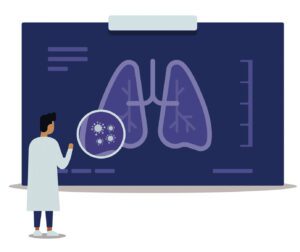 The beginning of a new year is the perfect time to draw attention to lung cancer, the leading cause of cancer death in America, accounting for 24% of cancer deaths. What is particularly troubling about this statistic is that caught early, lung cancer may be highly treatable. The best way to catch lung cancer early is through regular lung cancer screening.
The beginning of a new year is the perfect time to draw attention to lung cancer, the leading cause of cancer death in America, accounting for 24% of cancer deaths. What is particularly troubling about this statistic is that caught early, lung cancer may be highly treatable. The best way to catch lung cancer early is through regular lung cancer screening.
Once symptoms like chronic cough, wheezing or other problems appear, they signal the spread of cancer outside of the lungs, when it is often impossible to treat. That’s why it’s important to get screened while you feel healthy and are symptom-free. The recommended screening for lung cancer is Low Dose Computed Tomography, or LDCT. This painless, noninvasive CT scan uses a low dose of radiation to highlight detailed images of the lungs in just minutes, without the need for contrast dye. LDCT is capable of discovering nodules even when they are very tiny, and most easily treated.
LDCT vs. Chest X-ray
According to studies by the American Cancer Society and The National Lung Screening Trial, LDCT screening provides greater accuracy than chest x-ray, saving 20% more lives. For 1 in 5 patients diagnosed with lung cancer through routine screening, that’s a vitally important difference. So, if you’re in a higher risk group for lung cancer, LDCT is the clear choice, and the one more cancer and health organizations recommend.
Who Should Get LDCT Lung Cancer Screening?
Between 80-90% of lung cancer cases occur in current and former heavy smokers. The US Preventive Services Task Force recommends annual LDCT screening if you meet the following three criteria:
1. You are between 55 and 80 years old;
2. You have a history of heavy smoking; and
3. You currently smoke or quit within the past 15 years
What exactly is “heavy smoking”? Heavy smoking refers to a history of 30 or more “pack years,” which is measured by how many packs you smoke (or smoked) per day multiplied by how many years you spent smoking. For example, if you smoked one pack a day for 30 years or two packs a day for 15 years, you have reached 30 pack years. Even after you quit, you will remain in an elevated risk group until you have stopped for at least 15 years. So, while quitting is wonderful (and you have every reason to be proud of the accomplishment), you should remain vigilant until you have been smoke-free for 15 years.
Why RAO is the Right Choice for LDCT
Not all medical and radiological facilities have the right type of CT technology or the necessary experience in LDCT lung cancer screening to provide ultimate accuracy. RAO has a team of Board Certified specialists who are fellowship-trained in diagnostic radiology. RAO is accredited in CT technologies and designated a Lung Cancer Screening Center by the American College of Radiology. Should your screening reveal some-thing questionable, our doctors are prepared to arrange appropriate follow-up testing and direct consultation with your doctor for the highest standard of care.
If you are or were a heavy smoker and are considering getting screened for lung cancer, talk to your doctor about whether LDCT from RAO is right for you. We are committed to spotting problems sooner, while always staying focused on you.
Radiology Associates of Ocala
(352) 671-4300
www.RAOcala.com
 Central Florida Health and Wellness Magazine Health and Wellness Articles of the Villages
Central Florida Health and Wellness Magazine Health and Wellness Articles of the Villages



